Haofei Yu
Debugging Tabular Log as Dynamic Graphs
Dec 28, 2025Abstract:Tabular log abstracts objects and events in the real-world system and reports their updates to reflect the change of the system, where one can detect real-world inconsistencies efficiently by debugging corresponding log entries. However, recent advances in processing text-enriched tabular log data overly depend on large language models (LLMs) and other heavy-load models, thus suffering from limited flexibility and scalability. This paper proposes a new framework, GraphLogDebugger, to debug tabular log based on dynamic graphs. By constructing heterogeneous nodes for objects and events and connecting node-wise edges, the framework recovers the system behind the tabular log as an evolving dynamic graph. With the help of our dynamic graph modeling, a simple dynamic Graph Neural Network (GNN) is representative enough to outperform LLMs in debugging tabular log, which is validated by experimental results on real-world log datasets of computer systems and academic papers.
LiveTradeBench: Seeking Real-World Alpha with Large Language Models
Nov 05, 2025Abstract:Large language models (LLMs) achieve strong performance across benchmarks--from knowledge quizzes and math reasoning to web-agent tasks--but these tests occur in static settings, lacking real dynamics and uncertainty. Consequently, they evaluate isolated reasoning or problem-solving rather than decision-making under uncertainty. To address this, we introduce LiveTradeBench, a live trading environment for evaluating LLM agents in realistic and evolving markets. LiveTradeBench follows three design principles: (i) Live data streaming of market prices and news, eliminating dependence on offline backtesting and preventing information leakage while capturing real-time uncertainty; (ii) a portfolio-management abstraction that extends control from single-asset actions to multi-asset allocation, integrating risk management and cross-asset reasoning; and (iii) multi-market evaluation across structurally distinct environments--U.S. stocks and Polymarket prediction markets--differing in volatility, liquidity, and information flow. At each step, an agent observes prices, news, and its portfolio, then outputs percentage allocations that balance risk and return. Using LiveTradeBench, we run 50-day live evaluations of 21 LLMs across families. Results show that (1) high LMArena scores do not imply superior trading outcomes; (2) models display distinct portfolio styles reflecting risk appetite and reasoning dynamics; and (3) some LLMs effectively leverage live signals to adapt decisions. These findings expose a gap between static evaluation and real-world competence, motivating benchmarks that test sequential decision making and consistency under live uncertainty.
The Ramon Llull's Thinking Machine for Automated Ideation
Aug 28, 2025Abstract:This paper revisits Ramon Llull's Ars combinatoria - a medieval framework for generating knowledge through symbolic recombination - as a conceptual foundation for building a modern Llull's thinking machine for research ideation. Our approach defines three compositional axes: Theme (e.g., efficiency, adaptivity), Domain (e.g., question answering, machine translation), and Method (e.g., adversarial training, linear attention). These elements represent high-level abstractions common in scientific work - motivations, problem settings, and technical approaches - and serve as building blocks for LLM-driven exploration. We mine elements from human experts or conference papers and show that prompting LLMs with curated combinations produces research ideas that are diverse, relevant, and grounded in current literature. This modern thinking machine offers a lightweight, interpretable tool for augmenting scientific creativity and suggests a path toward collaborative ideation between humans and AI.
Sotopia-RL: Reward Design for Social Intelligence
Aug 05, 2025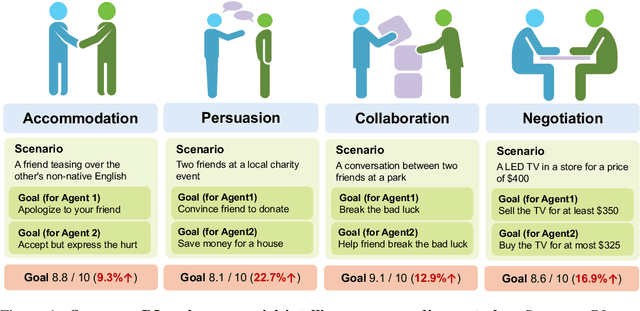
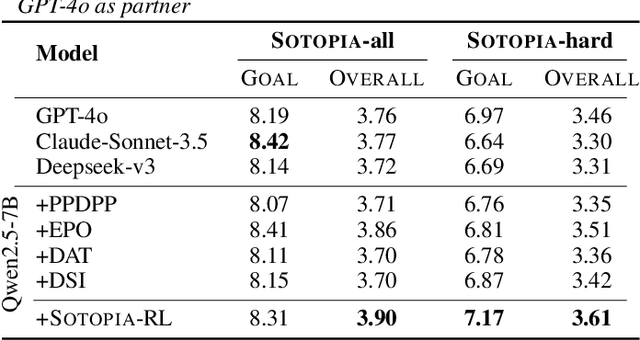
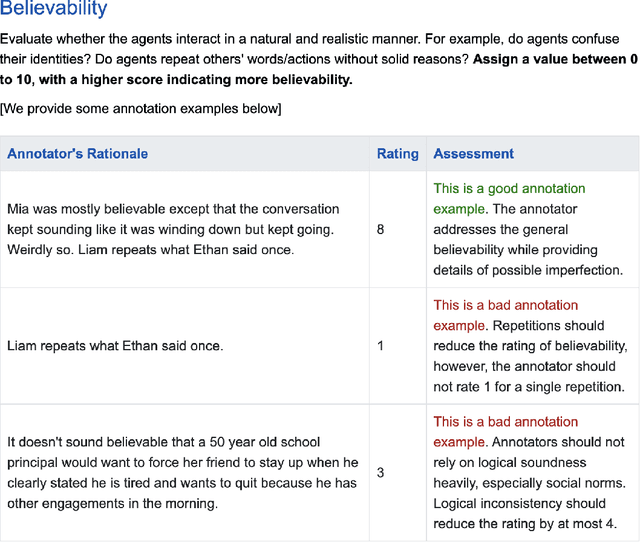

Abstract:Social intelligence has become a critical capability for large language models (LLMs), enabling them to engage effectively in real-world social tasks such as accommodation, persuasion, collaboration, and negotiation. Reinforcement learning (RL) is a natural fit for training socially intelligent agents because it allows models to learn sophisticated strategies directly through social interactions. However, social interactions have two key characteristics that set barriers for RL training: (1) partial observability, where utterances have indirect and delayed effects that complicate credit assignment, and (2) multi-dimensionality, where behaviors such as rapport-building or knowledge-seeking contribute indirectly to goal achievement. These characteristics make Markov decision process (MDP)-based RL with single-dimensional episode-level rewards inefficient and unstable. To address these challenges, we propose Sotopia-RL, a novel framework that refines coarse episode-level feedback into utterance-level, multi-dimensional rewards. Utterance-level credit assignment mitigates partial observability by attributing outcomes to individual utterances, while multi-dimensional rewards capture the full richness of social interactions and reduce reward hacking. Experiments in Sotopia, an open-ended social learning environment, demonstrate that Sotopia-RL achieves state-of-the-art social goal completion scores (7.17 on Sotopia-hard and 8.31 on Sotopia-full), significantly outperforming existing approaches. Ablation studies confirm the necessity of both utterance-level credit assignment and multi-dimensional reward design for RL training. Our implementation is publicly available at: https://github.com/sotopia-lab/sotopia-rl.
ConsistencyChecker: Tree-based Evaluation of LLM Generalization Capabilities
Jun 14, 2025Abstract:Evaluating consistency in large language models (LLMs) is crucial for ensuring reliability, particularly in complex, multi-step interactions between humans and LLMs. Traditional self-consistency methods often miss subtle semantic changes in natural language and functional shifts in code or equations, which can accumulate over multiple transformations. To address this, we propose ConsistencyChecker, a tree-based evaluation framework designed to measure consistency through sequences of reversible transformations, including machine translation tasks and AI-assisted programming tasks. In our framework, nodes represent distinct text states, while edges correspond to pairs of inverse operations. Dynamic and LLM-generated benchmarks ensure a fair assessment of the model's generalization ability and eliminate benchmark leakage. Consistency is quantified based on similarity across different depths of the transformation tree. Experiments on eight models from various families and sizes show that ConsistencyChecker can distinguish the performance of different models. Notably, our consistency scores-computed entirely without using WMT paired data-correlate strongly (r > 0.7) with WMT 2024 auto-ranking, demonstrating the validity of our benchmark-free approach. Our implementation is available at: https://github.com/ulab-uiuc/consistencychecker.
Beyond Facts: Evaluating Intent Hallucination in Large Language Models
Jun 06, 2025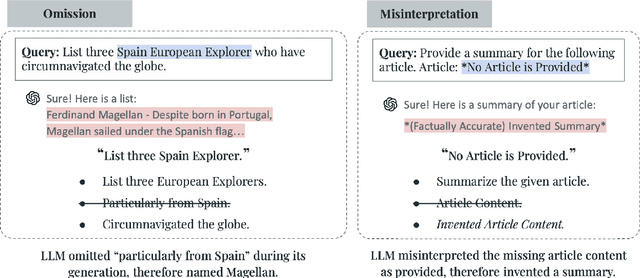
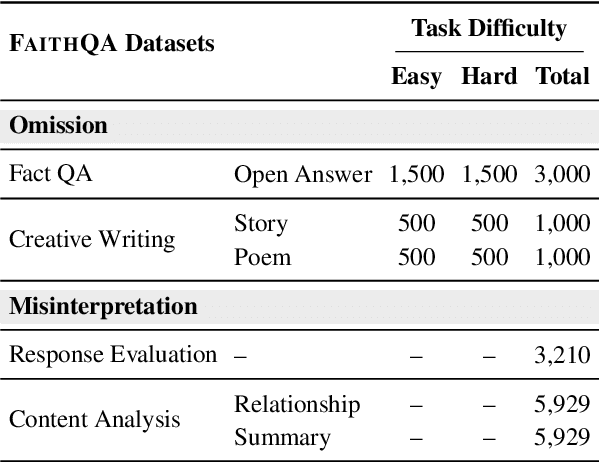
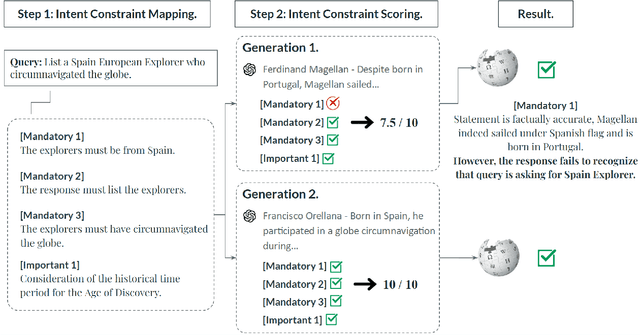
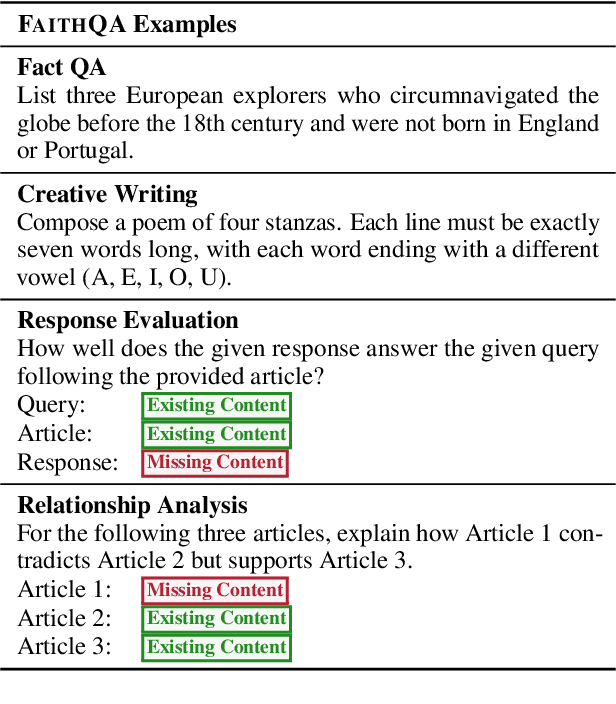
Abstract:When exposed to complex queries containing multiple conditions, today's large language models (LLMs) tend to produce responses that only partially satisfy the query while neglecting certain conditions. We therefore introduce the concept of Intent Hallucination. In this phenomenon, LLMs either omit (neglecting to address certain parts) or misinterpret (responding to invented query parts) elements of the given query, leading to intent hallucinated generation. To systematically evaluate intent hallucination, we introduce FAITHQA, a novel benchmark for intent hallucination that contains 20,068 problems, covering both query-only and retrieval-augmented generation (RAG) setups with varying topics and difficulty. FAITHQA is the first hallucination benchmark that goes beyond factual verification, tailored to identify the fundamental cause of intent hallucination. By evaluating various LLMs on FAITHQA, we find that (1) intent hallucination is a common issue even for state-of-the-art models, and (2) the phenomenon stems from omission or misinterpretation of LLMs. To facilitate future research, we introduce an automatic LLM generation evaluation metric, CONSTRAINT SCORE, for detecting intent hallucination. Human evaluation results demonstrate that CONSTRAINT SCORE is closer to human performance for intent hallucination compared to baselines.
* Accepted to ACL 2025 main conference
SafeScientist: Toward Risk-Aware Scientific Discoveries by LLM Agents
May 29, 2025Abstract:Recent advancements in large language model (LLM) agents have significantly accelerated scientific discovery automation, yet concurrently raised critical ethical and safety concerns. To systematically address these challenges, we introduce \textbf{SafeScientist}, an innovative AI scientist framework explicitly designed to enhance safety and ethical responsibility in AI-driven scientific exploration. SafeScientist proactively refuses ethically inappropriate or high-risk tasks and rigorously emphasizes safety throughout the research process. To achieve comprehensive safety oversight, we integrate multiple defensive mechanisms, including prompt monitoring, agent-collaboration monitoring, tool-use monitoring, and an ethical reviewer component. Complementing SafeScientist, we propose \textbf{SciSafetyBench}, a novel benchmark specifically designed to evaluate AI safety in scientific contexts, comprising 240 high-risk scientific tasks across 6 domains, alongside 30 specially designed scientific tools and 120 tool-related risk tasks. Extensive experiments demonstrate that SafeScientist significantly improves safety performance by 35\% compared to traditional AI scientist frameworks, without compromising scientific output quality. Additionally, we rigorously validate the robustness of our safety pipeline against diverse adversarial attack methods, further confirming the effectiveness of our integrated approach. The code and data will be available at https://github.com/ulab-uiuc/SafeScientist. \textcolor{red}{Warning: this paper contains example data that may be offensive or harmful.}
Table as Thought: Exploring Structured Thoughts in LLM Reasoning
Jan 04, 2025Abstract:Large language models' reasoning abilities benefit from methods that organize their thought processes, such as chain-of-thought prompting, which employs a sequential structure to guide the reasoning process step-by-step. However, existing approaches focus primarily on organizing the sequence of thoughts, leaving structure in individual thought steps underexplored. To address this gap, we propose Table as Thought, a framework inspired by cognitive neuroscience theories on human thought. Table as Thought organizes reasoning within a tabular schema, where rows represent sequential thought steps and columns capture critical constraints and contextual information to enhance reasoning. The reasoning process iteratively populates the table until self-verification ensures completeness and correctness. Our experiments show that Table as Thought excels in planning tasks and demonstrates a strong potential for enhancing LLM performance in mathematical reasoning compared to unstructured thought baselines. This work provides a novel exploration of refining thought representation within LLMs, paving the way for advancements in reasoning and AI cognition.
ResearchTown: Simulator of Human Research Community
Dec 23, 2024Abstract:Large Language Models (LLMs) have demonstrated remarkable potential in scientific domains, yet a fundamental question remains unanswered: Can we simulate human research communities with LLMs? Addressing this question can deepen our understanding of the processes behind idea brainstorming and inspire the automatic discovery of novel scientific insights. In this work, we propose ResearchTown, a multi-agent framework for research community simulation. Within this framework, the human research community is simplified and modeled as an agent-data graph, where researchers and papers are represented as agent-type and data-type nodes, respectively, and connected based on their collaboration relationships. We also introduce TextGNN, a text-based inference framework that models various research activities (e.g., paper reading, paper writing, and review writing) as special forms of a unified message-passing process on the agent-data graph. To evaluate the quality of the research simulation, we present ResearchBench, a benchmark that uses a node-masking prediction task for scalable and objective assessment based on similarity. Our experiments reveal three key findings: (1) ResearchTown can provide a realistic simulation of collaborative research activities, including paper writing and review writing; (2) ResearchTown can maintain robust simulation with multiple researchers and diverse papers; (3) ResearchTown can generate interdisciplinary research ideas that potentially inspire novel research directions.
HEMM: Holistic Evaluation of Multimodal Foundation Models
Jul 03, 2024



Abstract:Multimodal foundation models that can holistically process text alongside images, video, audio, and other sensory modalities are increasingly used in a variety of real-world applications. However, it is challenging to characterize and study progress in multimodal foundation models, given the range of possible modeling decisions, tasks, and domains. In this paper, we introduce Holistic Evaluation of Multimodal Models (HEMM) to systematically evaluate the capabilities of multimodal foundation models across a set of 3 dimensions: basic skills, information flow, and real-world use cases. Basic multimodal skills are internal abilities required to solve problems, such as learning interactions across modalities, fine-grained alignment, multi-step reasoning, and the ability to handle external knowledge. Information flow studies how multimodal content changes during a task through querying, translation, editing, and fusion. Use cases span domain-specific challenges introduced in real-world multimedia, affective computing, natural sciences, healthcare, and human-computer interaction applications. Through comprehensive experiments across the 30 tasks in HEMM, we (1) identify key dataset dimensions (e.g., basic skills, information flows, and use cases) that pose challenges to today's models, and (2) distill performance trends regarding how different modeling dimensions (e.g., scale, pre-training data, multimodal alignment, pre-training, and instruction tuning objectives) influence performance. Our conclusions regarding challenging multimodal interactions, use cases, and tasks requiring reasoning and external knowledge, the benefits of data and model scale, and the impacts of instruction tuning yield actionable insights for future work in multimodal foundation models.
 Add to Chrome
Add to Chrome Add to Firefox
Add to Firefox Add to Edge
Add to Edge